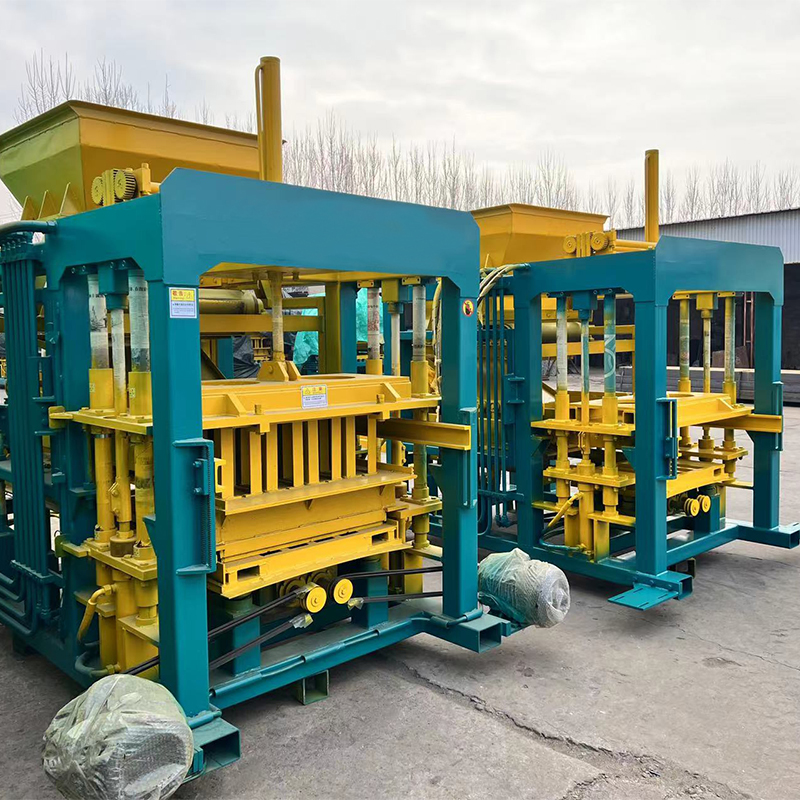
Image source :Aiweiblockmachine
The production process of interlocking bricks machines involves several stages that transform raw materials into finished interlocking bricks. This process is characterized by efficiency, automation, and environmentally-friendly practices. Here is an overview of the production process and output of interlocking bricks machines:
1. Raw Material Preparation: The process begins with the preparation of raw materials. The primary ingredients typically include soil, sand, cement, and sometimes stabilizers or additives. These materials are carefully mixed to achieve a consistent and uniform mixture that meets the desired quality standards.
2. Material Feeding: The prepared raw material mixture is then loaded into the interlocking bricks machine’s hopper. Depending on the machine’s design, this can be done manually or through automated material feeding systems.
3. Mixing and Homogenization: Inside the machine, the raw material mixture undergoes further mixing and homogenization. This step ensures that the different components are evenly distributed, resulting in bricks with consistent properties.
4. Compression and Molding: The mixed material is transferred to the mold within the machine. The compression process begins, where hydraulic pressure or mechanical force is applied to the mixture. The material is compacted within the mold to form the shape of the interlocking brick.
5. Interlocking Design Formation: During the compression process, the interlocking design is formed on the surface of the brick. This design includes grooves, ridges, and protrusions that enable the bricks to fit together seamlessly without the need for mortar or cement.
6. Ejection and Stacking: Once the compression is complete, the machine’s mold releases the pressure, allowing the newly formed interlocking brick to solidify. Depending on the machine’s configuration, the brick may be automatically ejected onto a conveyor or stacking system.
7. Curing and Drying: The freshly formed interlocking bricks are then transferred to a curing area. This area provides controlled conditions for the bricks to cure and dry. Curing enhances the brick’s strength and durability over time.
8. Quality Control and Inspection: Throughout the production process, quality control measures are implemented. Sensors, cameras, or manual inspections may be used to detect defects, inconsistencies, or deviations from specifications. This ensures that only high-quality interlocking bricks are released.
9. Final Output: The final output of the interlocking bricks machine is a batch of interlocking bricks that are uniform in size, shape, and quality. These bricks are characterized by their interlocking design, which enables them to fit together securely without the need for traditional mortar.
10. Sustainable Features: The production process of interlocking bricks machines aligns with sustainable construction practices. By reducing or eliminating the need for cement and mortar, these machines contribute to a reduction in carbon emissions and minimize environmental impact. Additionally, the use of locally sourced materials and efficient curing methods further enhances their sustainability.
11. Versatile Applications: The output of interlocking bricks machines can be used for a wide range of construction applications. These include building walls, pavements, driveways, pathways, landscaping features, and even roofing solutions.
12. Automation and Control: The production process of interlocking bricks machines is characterized by a high degree of automation and precise control. Automated systems handle tasks such as material feeding, mixing, compression, ejection, and sometimes even curing. Advanced control systems ensure consistency in brick dimensions, compression pressure, and interlocking design, resulting in uniform and high-quality output.
13. Energy Efficiency: Many modern interlocking bricks machines are designed with energy-efficient components and systems. Hydraulic and mechanical systems are optimized to minimize energy consumption while maintaining high production rates. This focus on energy efficiency contributes to cost savings and environmental sustainability.
14. High Production Capacity: Interlocking bricks machines are capable of producing a substantial number of bricks in a relatively short period. The high production capacity makes these machines suitable for large-scale construction projects, helping to accelerate construction timelines.
15. Precision Molding: The compression process in interlocking bricks machines ensures precision molding. The hydraulic or mechanical force applied during compression results in tightly compacted bricks with consistent dimensions and interlocking patterns. This precision enhances the structural integrity and aesthetic appeal of the final product.
16. Minimal Post-Production Handling: Interlocking bricks produced by these machines require minimal post-production handling. Since the bricks interlock naturally, there is no need for manual application of mortar or adhesive. This feature speeds up construction and reduces labor requirements.
17. Eco-Friendly Attributes: The production process of interlocking bricks machines aligns with eco-friendly construction practices. By minimizing the use of cement and eliminating the need for mortar, these machines contribute to reduced carbon emissions. Additionally, the option to use locally available soil and stabilizers reduces the environmental impact associated with transporting materials.
18. Adaptability to Local Conditions: Interlocking bricks machines are designed to work with a variety of raw materials, including soil with varying compositions. This adaptability to local conditions allows construction projects to utilize available resources, reducing the need for importing materials and promoting sustainable practices.
19. Faster Construction Speed: The use of interlocking bricks machines accelerates construction speed due to the efficiency of the production process and the ease of brick installation. Interlocking bricks can be laid quickly and securely, resulting in faster project completion compared to traditional bricklaying methods.
20. Reduced Construction Costs: Interlocking bricks machines offer the potential for reduced construction costs. By eliminating the need for skilled labor in mortar application and speeding up construction timelines, these machines contribute to cost savings for both labor and materials.
21. Diverse Applications: The output of interlocking bricks machines is versatile and can be used in various construction applications. The interlocking bricks are suitable for building walls, pavements, driveways, landscaping elements, schools, housing, and even disaster-resistant structures.
Conclusion: The production process and output of interlocking bricks machines showcase a range of features that contribute to sustainable, efficient, and cost-effective construction practices. By leveraging automation, energy efficiency, and eco-friendly materials, these machines are transforming the way buildings and infrastructure are constructed, paving the way for a more innovative and sustainable construction industry.
